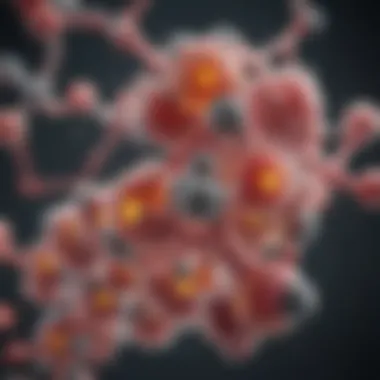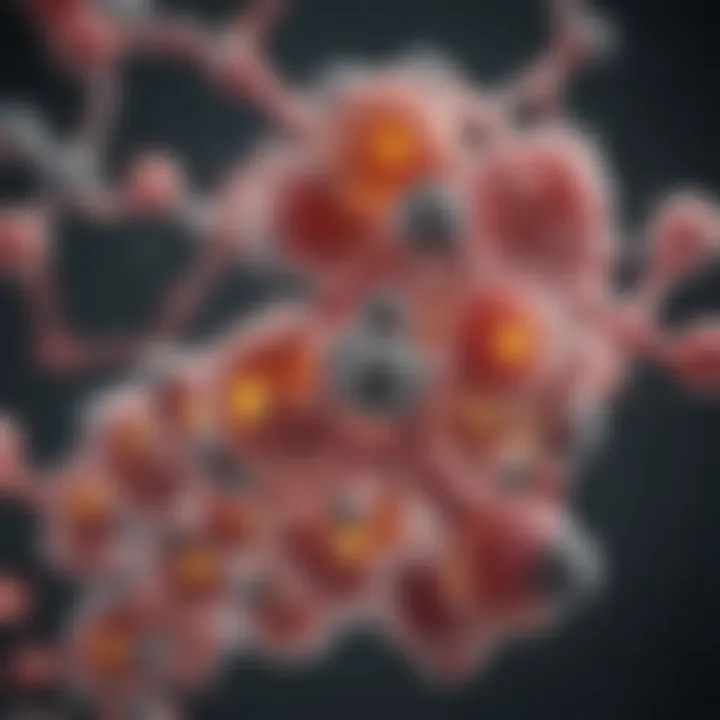Exploring Alternatives to Penicillin: Insightful Overview


Intro
The urgency for alternatives to penicillin has grown substantially due to the rising threat of antibiotic resistance. With overuse and misuse of antibiotics leading to resistant strains of bacteria, health experts are increasingly tasked with finding effective options beyond traditional penicillin-based treatments. This article presents a thorough examination of various substitutes available today, including their mechanisms of action, effectiveness, and potential applications.
The exploration encompasses natural compounds, synthetic alternatives, and what the future may hold in this area. Understanding these aspects is crucial for students, researchers, educators, and professionals seeking to enhance their knowledge in medical practice and pharmaceutical development.
Research Overview
Key Findings
Research indicates that several alternatives have emerged as viable options to combat infections traditionally treated with penicillin. These include, but are not limited to, compounds derived from marine organisms, plant extracts, and synthetic drugs designed to target bacterial mechanisms resistant to penicillin.
- Natural Alternatives: Some natural products exhibit antibacterial properties. For instance, extracts from Garlic and Honey have shown effectiveness against specific bacteria, suggesting their use in complementary medicine.
- Synthetic Compounds: New synthetic antimicrobials are being developed to target penicillin-resistant strains, such as linezolid.
Study Methodology
To gather a comprehensive understanding of alternatives to penicillin, a combination of literature review and clinical data analysis was employed. Peer-reviewed articles, recent clinical guidelines, and empirical research studies were sourced to provide accurate and up-to-date information.
- Literature Review: This involved analysis of academic journals and databases focusing on antibiotic alternatives.
- Clinical Trials: Reviewing data from recent trials helped assess efficacy and safety profiles of various alternatives.
Data was analyzed to highlight efficacy, side effects, and resistance patterns associated with these alternatives, yielding critical insights into their practical implications in medical settings.
Background and Context
Historical Background
The development of penicillin marked a significant milestone in medicine. Introduced in the 1940s, its efficacy revolutionized treatment for bacterial infections. However, the widespread use soon led to the problem of resistance, prompting interest in alternative treatments.
Current Trends in the Field
Antibiotic resistance is becoming ingrained in medical conversations today. The focus is shifting toward sustainable practices in antibiotic use. Research into phage therapy, probiotics, and innovative vaccine development presents exciting avenues worth exploring. Keeping pace with these trends is vital for healthcare professionals and researchers alike in order to safeguard public health.
"Exploring alternatives to penicillin offers hope not only for current treatment options but also enhances our understanding of bacterial behavior."
In summary, the search for substitutes to penicillin is a pressing issue shaped by the rise of antibiotic resistance. A comprehensive examination of natural and synthetic alternatives can illuminate pathways toward more effective treatments.
Prelims to Penicillin and Its Role in Medicine
Penicillin represents a cornerstone in modern medicine. Its introduction revolutionized the treatment of bacterial infections and altered the course of human health. This section highlights the relevance of understanding penicillin and its contributions to the medical landscape as we explore alternatives. The knowledge of penicillin lays the groundwork to comprehend the challenges we face today, especially regarding antibiotic resistance.
History of Penicillin Discovery
Penicillin was discovered by Alexander Fleming in 1928. The story goes that Fleming noticed a mold called Penicillium notatum inhibiting bacterial growth in one of his petri dishes. This serendipitous finding led to the isolation of penicillin. In the early 1940s, Howard Florey and Ernst Boris Chain developed a method for mass production, making it widely available during World War II. This was crucial for treating soldiers' infections, resulting in many lives saved. Discovering penicillin marked the dawn of antibiotics, offering hope against bacterial diseases.
Mechanism of Action
Penicillin functions primarily by disrupting the synthesis of the bacterial cell wall. It binds to specific proteins on the bacterial surface called penicillin-binding proteins (PBPs). This action inhibits peptidoglycan cross-linking, essential for maintaining cell wall integrity. As a result, bacteria become unable to withstand osmotic pressure and ultimately undergo lysis. It is especially effective against gram-positive bacteria, which are more susceptible due to their thick cell walls. This mechanism made penicillin a widely used antibiotic. However, its effectiveness is compromised against resistant strains, pushing the search for alternatives.
Current Applications
Today, penicillin is primarily used to treat a variety of infections, including:
- Streptococcal infections: Such as strep throat.
- Pneumococcal infections: Including pneumonia.
- Meningococcal diseases: Used for meningitis.
Despite its wide applications, the rise in antibiotic resistance has limited its use. Many bacteria have evolved mechanisms to evade the action of penicillin, rendering it less effective in certain cases. Continued reliance on penicillin also prompts the need for alternative solutions. As healthcare professionals face these challenges, it becomes essential to explore and evaluate substitutes for penicillin.


The Rise of Antibiotic Resistance
The rise of antibiotic resistance is a crucial aspect of modern medicine. As strains of bacteria evolve, they develop the ability to resist the effects of antibiotics. This situation raises significant concerns regarding the effectiveness of existing treatments. Understanding antibiotic resistance is essential for healthcare professionals and researchers alike. Addressing this issue is vital for ensuring effective treatments for infectious diseases. The emergence of resistant bacteria makes it increasingly necessary to explore alternatives to penicillin.
Understanding Antibiotic Resistance
Antibiotic resistance occurs when bacteria change in response to the use of antibiotics. When patients use antibiotics, they often eliminate susceptible bacteria. However, resistant strains may survive and reproduce. Over time, this leads to the spread of resistant infections. Various mechanisms contribute to resistance. These mechanisms include genetic mutations and the acquisition of resistance genes from other bacteria.
The World Health Organization emphasizes that antibiotic resistance is one of the biggest threats to global health. Without effective antibiotics, many medical procedures would become riskier. This includes surgeries, chemotherapy and treatment for chronic diseases.
Factors Contributing to Resistance
Several key factors contribute to antibiotic resistance. These include:
- Overuse of Antibiotics: Unnecessary prescriptions lead to increased exposure of bacteria to antibiotics. This facilitates the development of resistant strains.
- Inadequate Treatment: Patients not completing their antibiotic courses can leave resistant bacteria to thrive and spread.
- Agricultural Use: The use of antibiotics in livestock promotes resistance. Antibacterial agents are often added to animal feed, enhancing the risk of transmission to humans.
- Poor Infection Control: In healthcare settings, insufficient sterilization techniques can facilitate the spread of resistant strains.
Understanding these factors is pivotal for addressing antibiotic resistance effectively. It calls for a multifaceted approach in combating this growing issue.
Impact on Public Health
The implications of antibiotic resistance for public health are profound. Infections caused by resistant bacteria lead to longer hospital stays, higher medical costs, and increased mortality. Estimates suggest that millions of infections annually in the United States alone are attributed to antibiotic-resistant bacteria. The economic burden associated with these infections can strain healthcare systems significantly.
"Antibiotic resistance is an urgent global health threat, requiring both immediate and sustained action across all sectors."
The urgency reflects the need for heightened awareness and intervention strategies, including public education and better antibiotic stewardship. Preventing further resistance is not just a healthcare issue, but a societal one that demands collaborative efforts to safeguard future generations from the dangers of resistant infections.
Existing Penicillin Substitutes
The search for alternatives to penicillin has become increasingly essential in modern medicine. The advent of antibiotic resistance highlights a significant gap in treatment options, making the exploration of existing substitutes more crucial. This section will look at various classes of antibiotics that can serve as substitutes to penicillin, their mechanisms of action, effectiveness, and specific considerations to keep in mind when using them. Understanding these alternatives can inform clinical decisions and improve patient outcomes.
Cephalosporins
Cephalosporins are a class of antibiotics closely related to penicillin. They are derived from the fungus Cephalosporium acremonium and exhibit a broad spectrum of antibacterial activity. Cephalosporins are often categorized into generations, each expanding on the efficacy against Gram-positive and Gram-negative bacteria. The first-generation cephalosporins, like cephalexin, target primarily Gram-positive organisms, whereas later generations offer enhanced activity against Gram-negative pathogens.
These antibiotics can be used in various infections, including respiratory tract infections, urinary tract infections, and skin infections. Notable benefits of cephalosporins include their stability against beta-lactamases, enzymes produced by some bacteria that render penicillin ineffective. However, an important consideration is that patients with a history of penicillin allergy may also react to cephalosporins due to structural similarities.
Macrolides
Macrolides, such as azithromycin and erythromycin, are another vital class of antibiotics. They function by inhibiting bacterial protein synthesis, thus preventing the growth and replication of bacteria. These drugs are particularly effective against aerobic Gram-positive bacteria and some atypical pathogens.
The advantage of macrolides lies in their broader action against respiratory pathogens and their ability to penetrate tissues effectively. They are often used for treating conditions like community-acquired pneumonia, streptococcal infections, and even some skin infections. However, a crucial point to consider is that macrolides have potential drug interactions, especially with medications metabolized by the liver. Hence, caution is warranted in polypharmacy scenarios.
Glycopeptides
Glycopeptides, including vancomycin, are significant in treating serious Gram-positive infections. They also inhibit cell wall synthesis but are not related to penicillin. Glycopeptides are particularly crucial for treating methicillin-resistant Staphylococcus aureus (MRSA) infections.
Vancomycin is often reserved for severe infections due to its association with more toxic side effects, including nephrotoxicity. It's imperative to monitor renal function during treatment. While glycopeptides provide valuable options for resistant organisms, their use narrows potential therapeutic avenues due to rising resistance in some cases.
Tetracyclines
Tetracyclines, such as doxycycline and minocycline, are broad-spectrum antibiotics that inhibit protein synthesis by binding to the ribosomal subunits of bacteria. This class is effective against a wide array of bacteria, including both Gram-positive and negative organisms as well as some protozoa.
Beyond treating typical infections, tetracyclines have specific application in treating acne and certain tick-borne diseases. However, they have notable side effects, like photosensitivity and potential for tooth discoloration in children, calling for careful patient selection. Furthermore, due to resistance, tetracycline use needs to be substantiated with adequate susceptibility testing when treating infections.
The exploration of penicillin substitutes holds significant importance. Each class of antibiotics offers unique benefits and limitations—awareness and understanding improve their effective application in clinical settings.
Natural Alternative Antibiotics


Natural alternative antibiotics are gaining attention as viable substitutes for penicillin, particularly in light of increasing antibiotic resistance. These alternatives arise from natural sources and include plant-based compounds, essential oils, and probiotics. Understanding their significance is critical as they offer various benefits. They can minimize side effects, promote a natural balance of good bacteria, and have unique antimicrobial properties. This section will delve into three main types of natural alternative antibiotics, highlighting their effectiveness, applications, and considerations.
Plant-Based Compounds
Plant-based compounds have long been a cornerstone of traditional medicine. Many plants possess inherent properties that can inhibit bacterial growth. For instance, garlic and ginger are known for their antibacterial characteristics. Their natural compounds have shown to combat various strains of bacteria, making them suitable alternatives.
Research indicates that plant-derived substances, like berberine, found in plants such as goldenseal and barberry, display strong antibacterial activities. Moreover, many of these compounds are less likely to contribute to resistance compared to conventional antibiotics. This is a critical point, as antibiotic resistance continues to pose a significant threat to public health.
Essential Oils
Essential oils are concentrated plant extracts that possess diverse antimicrobial properties. Oils like tea tree and oregano oil have effectively demonstrated antibacterial effects. They are often used in alternative medicine and can be applied topically or diffused into the air.
A significant aspect of essential oils is their versatility. For instance, tea tree oil is known for its broad-spectrum antibacterial and antifungal properties. However, caution is necessary when using essential oils, as they can cause irritation when not properly diluted. Understanding the correct usage and potential interactions is essential to maximize their benefits.
Probiotics
Probiotics are live microorganisms that provide health benefits, particularly for gut health. Certain probiotic strains have exhibited antibacterial properties, assisting in maintaining a balanced microbiome. By outcompeting pathogens for resources, probiotics can reduce the risk of infections.
Studies have shown that specific strains, like Lactobacillus and Bifidobacterium, can enhance the body's immune response. Incorporating probiotics into a diet can support overall health and potentially diminish the reliance on traditional antibiotics.
Synthetic and Semi-Synthetic Antibiotics
Synthetic and semi-synthetic antibiotics are critical in the ongoing search for effective alternatives to penicillin. With the growing concern over antibiotic resistance, understanding these compounds becomes essential. They offer options that may bypass the resistance mechanisms some bacteria have developed against traditional antibiotics. Synthetic antibiotics are entirely created in laboratories, while semi-synthetic antibiotics are modified versions of naturally occurring antibiotic compounds. Each type has its unique benefits, drawbacks, and applications in treating infections.
Overview of Synthesis Methods
The methods used for synthesizing these antibiotics vary significantly. Synthetic antibiotics are produced through chemical processes that allow for precise control over their molecular structure. This control can lead to enhanced efficacy and reduced side effects. Common synthesis techniques include:
- Chemical Synthesis: Involves creating the antibiotic from simple chemical precursors. This method allows for the production of complex molecules that may not be easily found in nature.
- Modification of Natural Products: Semi-synthetic antibiotics are derived from pre-existing natural compounds. They undergo chemical modifications to improve their pharmacological properties.
- Biotechnological Approaches: Utilize microbial fermentation processes to produce antibiotics, often leading to new antibiotics with improved characteristics.
Challenges in Development
Despite the potential of synthetic and semi-synthetic antibiotics, several challenges persist in their development:
- Complexity of Bacterial Resistance: Developing antibiotics that are effective against resistant strains requires ongoing research and adaptation.
- Cost and Resource Intensity: The synthesis processes can be both costly and resource-intensive, which may limit access to these antibiotics in lower-income regions.
- Regulatory Hurdles: Navigating the pharmaceutical regulatory environment is challenging. Ensuring safety and efficacy requires extensive clinical trials, which can take years to complete.
Current Research Trends
Research around synthetic and semi-synthetic antibiotics is actively evolving. Some notable trends include:
- Targeting Resistant Bacteria: Research is focusing on understanding bacterial resistance mechanisms to develop antibiotics that circumvent these issues.
- New Classes of Antibiotics: Scientists are exploring novel structures that differ structurally from existing antibiotics, aiming to target new pathways in bacterial cells.
- Combination Therapies: Using synthetic antibiotics in combination with existing treatments may enhance effectiveness and minimize resistance development.
"The landscape of antibiotic development is rapidly changing, driven by the urgent need for effective treatments against resistant infections."
Overall, synthetic and semi-synthetic antibiotics represent a promising avenue in the fight against antibiotic resistance. Their development is vital for ensuring the availability of effective treatments in the future.
Future Directions in Antibiotic Development
The ongoing challenge of antibiotic resistance underscores the urgency for new antibiotic development. This section highlights several important aspects related to future directions in this field. It sheds light on innovative research approaches, emphasizes the role of genomics and bioinformatics, and discusses the significance of collaborative research initiatives.
Innovative Research Approaches
Innovative research approaches serve as a foundation for future antibiotic development. These methods leverage advancements in science and technology to enhance drug discovery and optimize antibiotic efficacy. For example, utilizing high-throughput screening methods allows researchers to test multiple compounds rapidly, identifying potential candidates more efficiently.
Moreover, artificial intelligence systems are being incorporated to predict how new compounds will behave in biological systems. This approach significantly reduces the time and cost usually associated with the drug development process. Another crucial element is the exploration of bacterial target pathways through systems biology, enabling the design of drugs that interfere with specific bacterial processes rather than broadly targeting the entire organism. This targeted strategy helps to minimize the chances of resistance emergence.


The potential of innovative research methods may redefine how antibiotics are discovered and developed, ultimately improving patient outcomes.
Role of Genomics and Bioinformatics
Genomics and bioinformatics are transforming the landscape of antibiotic development. These fields provide insights into the genetic makeup of pathogens, allowing for the identification of novel targets for antibiotic action. By analyzing genomic data, researchers can discover genetic variations that confer resistance, thereby guiding the design of new compounds that can bypass these mechanisms.
Bioinformatics tools aid in the modeling and simulation of drug interactions, which is vital for predicting how well a new antibiotic will perform against specific bacteria. The integration of these technologies enables a more personalized approach to treatment. For instance, tailoring antibiotic therapy based on the genetic profile of the infectious organism may lead to more effective outcomes and reduce the occurrence of treatment failure.
Collaborative Research Initiatives
Collaboration is essential in addressing the global threat posed by antibiotic resistance. Collaborative research initiatives involve partnerships between academic institutions, pharmaceutical companies, and governmental organizations. These alliances bring together diverse expertise and resources that can accelerate the invention and distribution of new antibiotics.
Such partnerships facilitate sharing of data, successful research strategies, and even financial investments. For example, the AMR Action Fund, which seeks to provide funding to biotech companies focusing on antibiotic research, exemplifies how pooled resources can help drive innovation in antibiotic development. By fostering collaboration, the scientific community can work together more effectively to overcome barriers and expedite the introduction of new antibiotics to the market.
Regulatory Considerations and Safety Profiles
Regulatory considerations play a crucial role in the development and approval of new antibiotics, particularly as interest grows in alternatives to penicillin. It involves diverse processes that ensure the safety and effectiveness of these drugs before they reach the market. When substituting antibiotics, healthcare practitioners rely on these regulations to address public health concerns and the rising tide of antibiotic resistance.
Approval Processes for New Antibiotics
The approval process for new antibiotics involves several stages. First, preclinical studies evaluate the drug's safety and efficacy in laboratory settings. Following successful preclinical results, a more extensive and controlled clinical trial procedure begins. This process is divided into three phases. Phase I assesses safety in healthy volunteers, Phase II tests efficacy and safety in a small group of patients, and Phase III examines the drug's effect across larger populations. Each phase offers detailed data that regulators, like the FDA and EMA, use to evaluate the antibiotic's benefits and risks thoroughly.
These approval processes have become particularly stringent due to the dire situation of antibiotic resistance. Hosts of antibiotics are being evaluated, with the goal being to ensure that new drugs can effectively combat resistant strains. Clinicians need to trust that any medication prescribed will act reliably against infections.
Adverse Effects and Interactions
Every new antibiotic carries the potential for adverse effects and interactions with other medications. Identifying these aspects is crucial not only for regulatory approval but also to inform healthcare providers and patients. During clinical trials, researchers carefully monitor side effects and report them to regulatory bodies.
Adverse effects can range from mild to severe. Sometimes, patients may experience gastrointestinal distress when taking certain antibiotics. More seriously, some antibiotics have been shown to interact negatively with other medications, which can escalate into dangerous situations for patients already on complicated regimens. For this reason, a detailed risk-benefit analysis is necessary prior to market release. It helps promote safer use of antibiotics in various patient demographics.
Post-Marketing Surveillance
Post-marketing surveillance, also known as pharmacovigilance, is the process of continuously monitoring the long-term effects and safety profiles of newly approved antibiotics after their release. This system is important because clinical trials, while comprehensive, often involve a limited number of participants and specific conditions.
Once a drug is on the market, the real-world usage scenarios and diverse patient backgrounds become apparent. For instance, rare adverse reactions may only surface when the drug is used widely in the general population. Regulatory agencies maintain databases to collect this data and facilitate reporting by healthcare professionals and patients alike. Consistent evaluation allows for timely updates, which may include labeling changes or recommendations for usage.
"The importance of monitoring antibiotic safety cannot be overstated, especially in the context of evolving bacterial resistance."
Overall, regulatory considerations and safety profiles are fundamental to the development and use of antibiotic alternatives. They safeguard public health, ensure clinical efficacy, and support the collaborative goal of combating antibiotic resistance.
Closure
The conclusion is a vital component of this article, encapsulating the essential insights gained from the exploration of penicillin alternatives. As antibiotic resistance continues to rise, understanding these alternatives becomes increasingly crucial. The shift to non-penicillin options can significantly influence treatment strategies in both acute and chronic infections, impacting patient outcomes and public health.
Summary of Findings
Recent research uncovered diverse categories of alternatives to penicillin, ranging from natural compounds to advanced synthetic antibiotics. Key findings include:
- Efficacy of natural alternatives: Compounds derived from plants, essential oils, and probiotics show promise as effective treatments against certain bacterial strains.
- Exploration of synthetic antibiotics: New methodologies in synthesis have led to the development of semi-synthetic options that retain effectiveness against resistant bacteria.
- Regulatory landscape: Navigating safety profiles and the approval process remains crucial for bringing new antibiotics to market, ensuring patient safety and drug efficacy.
Implications for Future Research
Future investigations must focus on several critical areas:
- Mechanistic studies: Understanding how these alternatives work at a molecular level can improve their application and integration into therapeutic regimens.
- Combination therapies: Research into using alternative antibiotics in conjunction with traditional ones could enhance treatment outcomes and delay resistance.
- Global health initiatives: Collaborative efforts among researchers and institutions can drive forward innovation in antibiotic development, aiding in the fight against infections worldwide.
The Path Forward
Moving ahead, the medical community must prioritize the exploration of alternatives to penicillin. There are some recommended actions:
- Increase funding for research on promising natural products and synthetic antibiotics.
- Educate healthcare professionals on the potential of these alternatives to empower informed prescribing practices.
- Establish partnerships among academic, industrial, and governmental organizations to share knowledge and resources.
By embracing these strategies, the healthcare landscape can evolve, ensuring effective treatment options remain accessible in the face of growing antibiotic resistance.







